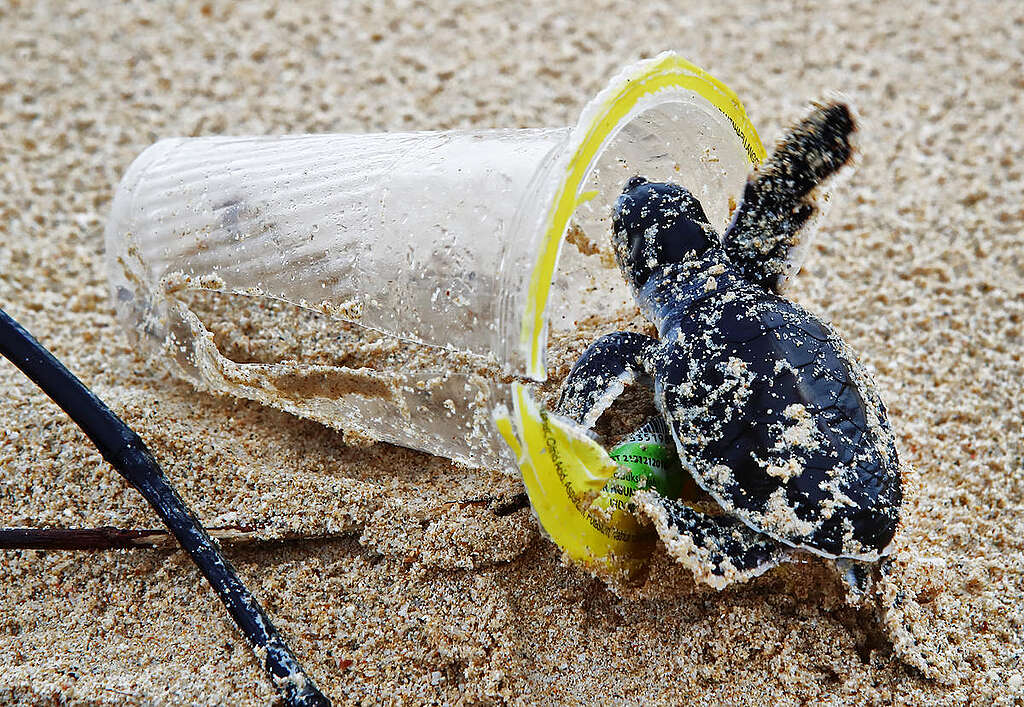Unilever is vocal about its desire to conduct business that does ‘more good for our planet and our society – not just less harm’.1 In recent years, it has been visible at conferences around the world, promoting its plan to use ‘less plastic, better plastic or no plastic’.2
In this report, Greenpeace International investigates the reality behind these soundbites. We expose the blight of Unilever’s single-use sachets on low-income communities and the glaring gap that exists between what the company says it will do, and what it actually does.
We conclude by urging Unilever to grasp the opportunity presented by the UN Global Plastics Treaty. The company must spearhead an industry-wide movement, one that transitions businesses away from single-use plastics and towards the adoption of at-scale reusable packaging systems around the world.
New Greenpeace International analysis shows that:
- Despite committing to using ‘less plastic, better plastic or no plastic’, Unilever’s plastic footprint has not decreased at all. The company produced 610,000 tonnes of plastic packaging in 2017,3 700,000 in 2018,4 700,000 in 2019,5 690,000 in 2020,6 reaching 713,000 tonnes in 2021,7 before dipping to 698,000 in 2022.8
- Unilever promised to cut its virgin plastic use in half by 2025. At its current trajectory, this won’t be achieved until at least 2034.9
- Unilever claims to want a ‘waste-free’ world, yet just 0.2% of its plastic packaging is currently reusable10 and the company has to date refused to set a reuse target.11
- If the company continues increasing its share of reusable packaging at its current rate, it will be the new millennium before it fully switches over to reuse.12
- Unilever is the biggest corporate seller of plastic sachets in the world,13 and is predicted to sell over 53 billion sachets in 2023 – 1,700 per second.14 Campaigns around the world have called for these sachets to be banned due to their appalling environmental and health impacts, particularly in Global South communities.
- The company first promised to tackle the problem of sachet waste in 2010. Instead, it went on to produce an estimated 475 billion over the next decade, steadily increasing sachet production by approximately 1-2 billion items a year.15
- Dove, Unilever’s most profitable ‘master’ brand, generates billions of units of single-use plastic each year, including an estimated 6.4 billion sachets, accounting for over 10% of Unilever’s total sachet sales.16

Single-use plastic is harmful to human health, perpetuates social injustice, destroys our biodiversity and fuels the climate crisis. We demand that governments commit to a strong Global Plastics Treaty that will stop runaway plastic production and use and ultimately end the age of plastic.
Get Involved1 Unilever (no date). ‘Our strategy’ https://www.unilever. com/our-company/strategy/
2 Unilever (n.d.) ‘Waste-free World’ https://www.unilever. com/planet-and-society/waste-free-world/
3 Unilever (2018, unpublished). ‘Unilever response to Greenpeace single-use plastic survey’
4 Ellen MacArthur Foundation (2019). Global Commitment 2019 Progress Report, p. 133 https://archive. ellenmacarthurfoundation.org/assets/downloads/Global- Commitment-2019-Progress-Report.pdf
5 Unilever (2019). ‘Unilever announces ambitious new commitments for a waste-free world’ https://www.unilever.com/ news/press-and-media/press-releases/2019/unilever-announces-ambitious-new-commitments-for-a-waste-free-world/
6 Unilever (2021). ‘Unilever Sustainable Living Plan 2010 to 2020: Summary of 10 years’ progress’, p.21 https://www.unilever.com/files/92ui5egz/ production/16cb778e4d31b81509dc5937001559f1f5c863ab.pdf
7 Ellen MacArthur Foundation (2022). ‘Global Commitment Progress Report 2022’, Unilever Packaging producers and users https://gc-22.emf.org/detail-ppu/?cid=Unilever
8 Ellen MacArthur Foundation (2023) .‘The Global Commitment 2023 Progress Report’ https://www. ellenmacarthurfoundation.org/global-commitment-2023/overview
9 In 2022, Unilever’s virgin plastic use was down 13% relative to 2019. Assuming that 13% is evenly spread over the three years 2020-2022, for a reduction of 4.3% per year it will take until 2034 until the total is less than 50% of the 2019 number. Unilever (2023). ‘Delivering sustainable business performance: Unilever Annual Report and Accounts 2022’ https://www.unilever.com/files/92ui5egz/ production/257f12db9c95ffa2ed12d6f2e2b3ff67db49fd60.pdf
10 Ellen MacArthur Foundation (2023). ‘The Global Commitment 2023 Progress Report’, p.9 https://www. ellenmacarthurfoundation.org/global-commitment-2023/overview
11 Greenpeace (2021, unpublished). Notes from meeting with Unilever.
12 The share of Unilever’s plastic packaging that was reusable in 2021/2022 was just 0.1% according to the Ellen MacArthur Foundation’s Global Commitment Report 2022 https:// gc-22.emf.org/detail-ppu/?cid=Unilever. This figure increased to 0.2% in the 2023 report https://gc-data.emf.org/2023/detail-ppu/?cid=unilever. If the company continued increasing its share of reusable packaging by 0.1% per year, it would be the new millennium before it fully switched its plastic packaging over to reuse.
13 Future Market Insights (2023, unpublished). ‘Sachet Packaging Market Report – Global Industry Analysis 2018-2022 and Opportunity Assessment 2023-2033’.
14 Future Market Insights (2023, unpublished). ‘Sachet Packaging Market Report – Global Industry Analysis 2018-2022 and Opportunity Assessment 2023-2033’, (2023 figures).
15 Future Market Insights (2023, unpublished). ‘Unilever’s Sachets Market – Unilever’s Sachets Brand Use by Personal Care and Beauty Brands by Country – Global Industry Analysis 2010- 2022 and Opportunity Assessment 2023-2033’, (p.2, Historic data of sachets for top F M C G brands (volume units)).

